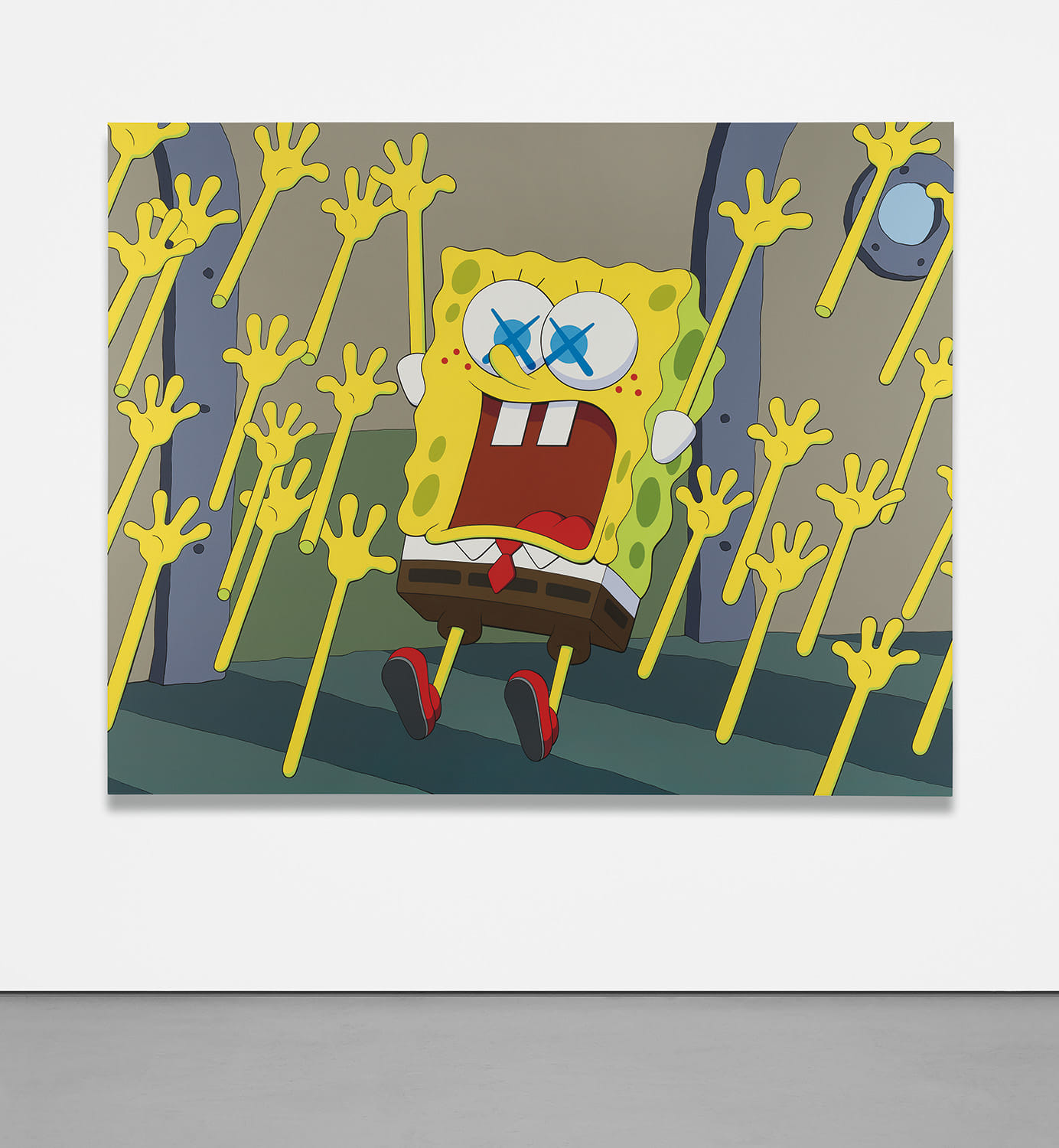



17Ο◆
KAWS
THE WALK HOME
Full-Cataloguing
In THE WALK HOME, the catalyst of SpongeBob’s overwhelming anxiety is placed beyond the confines of the picture plane. The audible manifestation of the scene is conveyed in the repeated arms contained within the compositional frame, that ostensibly function like the physical action exclamations of cartoons like “POW!” or “BAM!”. This technique more aptly recalls a scene on infinite loop, one that never comes to narrative fruition, rather than a cartoon strip. In so doing, KAWS succeeds in emphasizing the magnitude of emotion captured in a single moment. By starting with the cartoon as his reference point, a genre characterized by short narratives, KAWS utilizes the televised series’ simplification for his greater goal. Combined with his deconstructive approach of isolating parts of the whole to comprise his seemingly familiar vignettes, KAWS complicates the viewer’s narrative reading of the scene and compels us to imbue the work with our own suppositions. As curator Mónica Ramírez-Montagut explains, “…we recognize the cartoon characters yet, with KAWS’s intervention, the meaning becomes somewhat subverted…Since we are familiar with these characters…we in fact feel empowered to ponder the meaning and have an opinion. Thus it is up to us to decide whether these are homages or criticisms” (Mónica Ramírez-Montagut, KAWS, exh. brochure, The Aldrich Contemporary Art Museum, Ridgefield, 2010, online).
Despite being rooted in their source imagery, KAWS’s paintings are not appropriations of specific animated cartoon narratives but rather broader interrogations of universal human emotions. Of his practice, KAWS has espoused, “even though I use a comic language, my figures are not always reflecting the idealistic cartoon view that I grew up on, where everything has a happy ending” (KAWS, quoted in KAWS: WHERE THE END STARTS, exh. cat., Modern Art Museum of Fort Worth, Fort Worth, 2016, p. 5). Indeed the overtly emotional reaction KAWS conveys here with SpongeBob, which is further reinforced by the repeated limbs in the air, seems to have more in common with such emotionally-laden works as Francisco de Goya’s politically charged The Third of May 1808 than any plotline from the children’s cartoon show. With this in mind, THE WALK HOME serves primarily as a study in pure human emotion, one that is universally understood and transcends nationality, culture and time.
The conflation of high and low culture is a common thread throughout KAWS’s varied and diverse practice, which includes painting, sculpture, printmaking, street art and clothing design. Following his limited edition toys of the late 1990s, of which the subjects were KAWS’s own creations, the artist turned to familiar television and cartoon icons such as The Simpsons, Mickey Mouse, the Smurfs, and SpongeBob in the early 2000s. Created by marine science educator Stephen Hillenburg in the late 1990s, SpongeBob SquarePants is the highest rated series to ever air on the children’s cartoon network, Nickelodeon. Speaking about his use of SpongeBob’s character in his practice, KAWS said “…SpongeBob was something I wanted to do because graphically I love the shapes. But honestly, when I’m painting SpongeBob, I’m not thinking, ‘Oh, I loved this episode.’ Honestly, I’ve never even watched it” (KAWS, quoted in Tobey Maguire, “KAWS”, Interview Magazine, April 27, 2010, online).
KAWS
American | 1974To understand the work of KAWS is to understand his roots in the skateboard and graffiti crews of New York City. Brian Donnelly chose KAWS as his moniker to tag city streets beginning in the 1990s, and quickly became a celebrated standout in the scene. Having swapped spray paint for explorations in fine art spanning sculpture, painting and collage, KAWS has maintained a fascination with classic cartoons, including Garfield, SpongeBob SquarePants and The Simpsons, and reconfigured familiar subjects into a world of fantasy.
Perhaps he is most known for his larger-than-life fiberglass sculptures that supplant the body of Mickey Mouse onto KAWS' own imagined creatures, often with 'x'-ed out eyes or ultra-animated features. However, KAWS also works frequently in neon and vivid paint, adding animation and depth to contemporary paintings filled with approachable imagination. There is mass appeal to KAWS, who exhibits globally and most frequently in Asia, Europe and the United States.